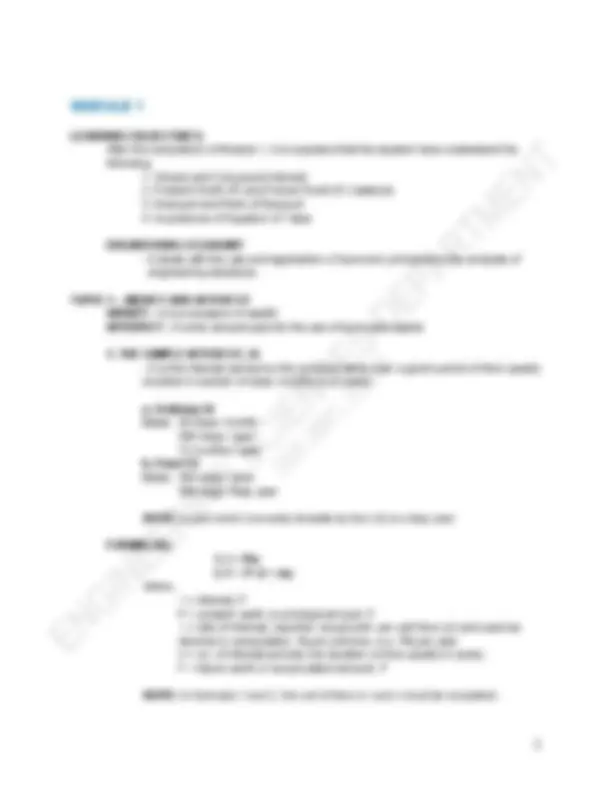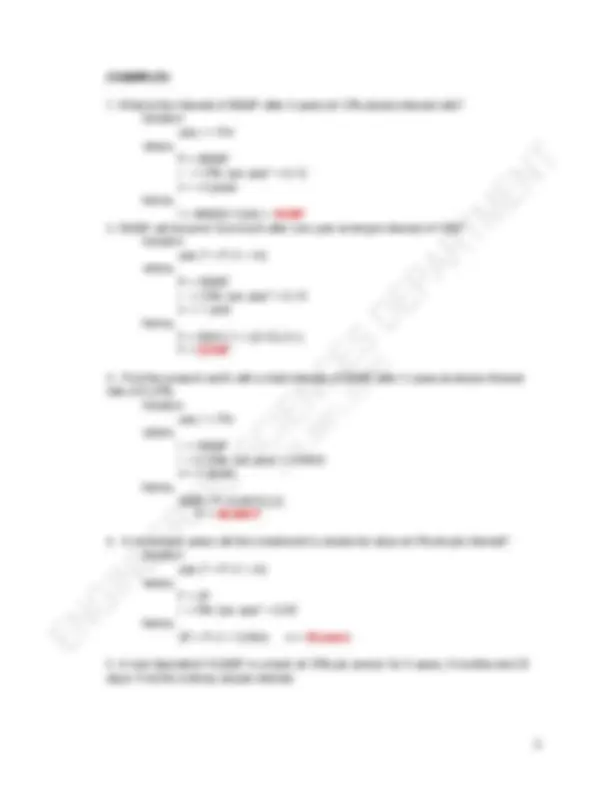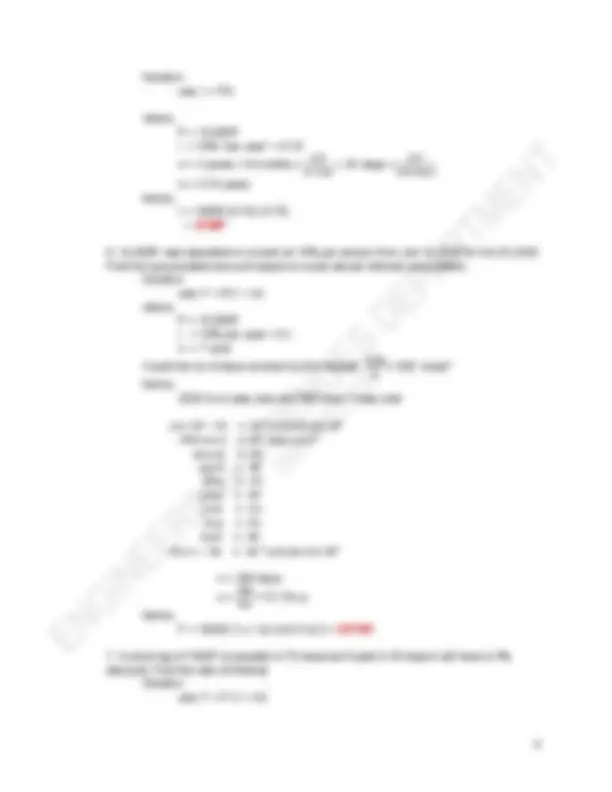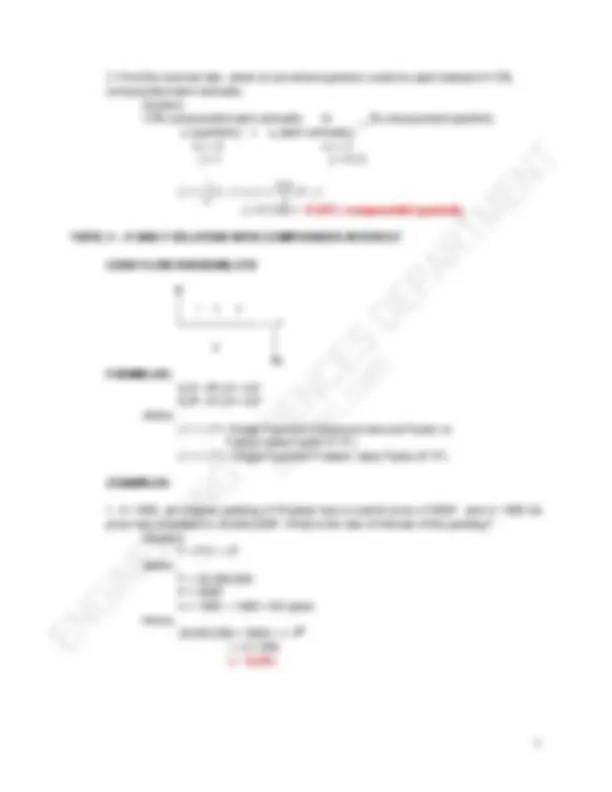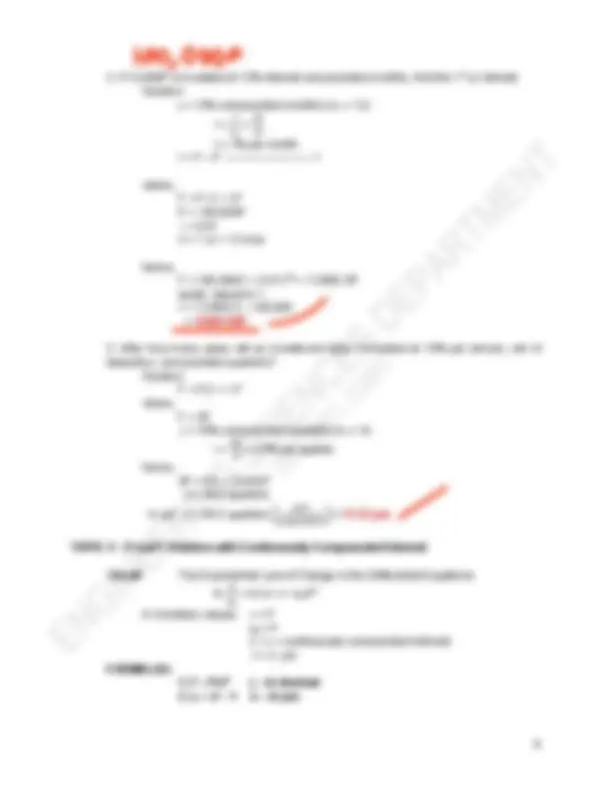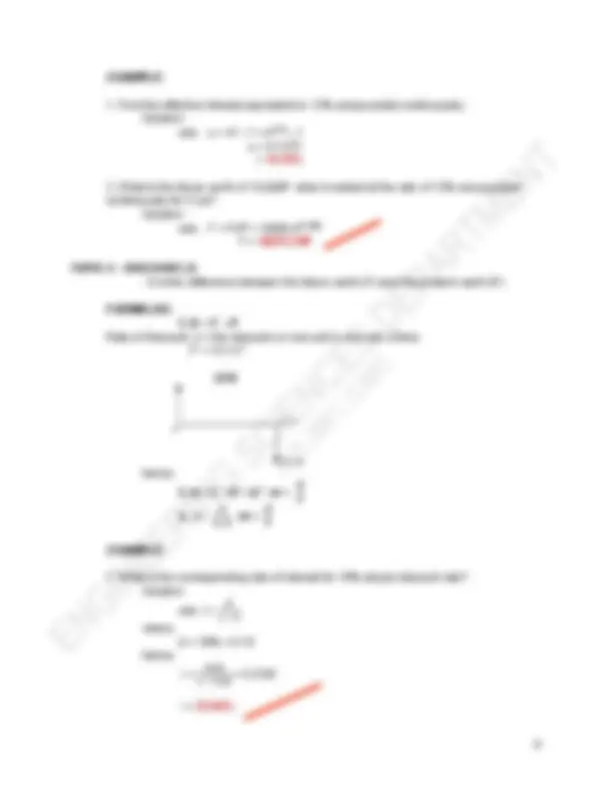Download Lecture for Module 1 in Engineering Economics and more Lecture notes Engineering Economy in PDF only on Docsity!
ENSC 2063 / ENSC 20093
ENGINEERING ECONOMY/
ENGINEERING ECONOMICS
BY
FACULTY OF ENGINEERING SCIENCES DEPARTMENT, ESD 2020
Engr. Maricar B. Carreon Engr. Babinezer D. Memoracion
Engr. Eduardo O. Dadivas Engr. Jimmy L. Ocampo
Engr. Carmelita I. Durias Engr. Ruben A. Pureza
Engr. Angela L. Israel Engr. Roland C. Viray
ENGINEERING ECONOMY
INSTRUCTIONAL MATERIAL
THE OVERVIEW
This instructional material (IM) for Engineering Economy will give the students a good understanding on what is the time value of money like the present worth and future relation and how rate of interest affects their respective values. Likewise, it will also show the importance of equation of value and its use to solve various problems in this subject. Similarly, it will also show the different types of annuity and how depreciation changes the worth of a property due to passage of time. It will also give the importance of break-even point in decision making whether a company can make or break in its operation. Several sample problems are presented as guide to solve the problems in the assessments at the end of each module which eventually will give the student a chance to master the use of formulas as presented in this instructional material. THE LEARNING OBJECTIVES This instructional material (IM) for the subject Engineering Economy will discuss the topics which are commonly given in the Engineering Board Examination such as;
- Simple Interest
- Compound Interest
- Present Worth (P) and Future Worth (F) Relations
- Discount and Rate of Discount
- Importance of Equation of Value
- Annuity and Amortizations
- Arithmetic and Geometric Gradients
- Capitalized cost
- Bond Value Calculation
- Depreciation and Depletion
- Break-Even Analysis and Profit Computation COURSE MATERIALS:
- Engineering Economy by de Garmo
- Engineering Economy by Blank et.al.
- Engineering Economy by Arreola
- Engineering Economy by Sta Maria
- Simplified Engineering Economy by Ocampo et.al.
- Engineering Economy by Engr. Jimmy L. Ocampo at youtube.com
EXAMPLES:
- What is the interest of 8600P after 4 years at 12% simple interest rate? Solution: use, I = Pin where, P = 8600P i = 12% ³SeU \eaU´ = 0. n = 4 years hence, I = 8600(0.12)(4) = 4128 P
- 5000P will become how much after one year at simple interest of 15%? Solution: use, F = P (1 + in) where, P = 5000P i = 15% ³SeU \eaU´ = 0. n = 1 year hence, F = 5000 { 1 + (0.15) (1) } F = 5750 P
- Find the present worth with a total interest of 5000P after 2 years at simple interest rate of 6.25%. Solution: use, I = Pin where, I = 5000 P i = 6.25% ³SeU \eaU´ = 0. n = 2 years hence, 5000 = P (0.0625) (2) P = 40,000 P
- In how many years will the investment to double its value at 5% simple interest? Solution: use, F = P (1 + in) where, F = 2P i = 5% ³SeU \eaU´ = 0. hence, 2P = P (1 + 0.05n) n = 20 years
- A man deposited 10,000P in a bank at 10% per annum for 3 years, 8 months and 25 days. Find the ordinary simple interest.
Solution: use, I = Pin where, P = 10,000P i = 10% ³SeU \eaU´ = 0. n = 3 years + 8 months x 1 𝑦𝑟 12 𝑚𝑜𝑠
- 25 days x 1 𝑦𝑟 360 𝑑𝑎𝑦𝑠 n = 3.74 years hence, I = 10000 (0.10) (3.74) = 3740 P
- 10,000P was deposited in a bank at 10% per annum from Jan 15,2020 to Oct 25,2020. Find the accumulated amount based on exact simple interest computation. Solution: use, F = P(1 + in) where, P = 10,000P i = 10% per year = 0. n =? year Count the no of days covered by the deposit, 2020 4 = 505 ³e[acW´ hence, 2020 is a Leap year and 366 days / Leap year 𝐽𝑎𝑛 15 െ 31 ൌ 16 "𝑒𝑥𝑐𝑙𝑢𝑑𝑒 𝐽𝑎𝑛 15" 𝐹𝑒𝑏𝑟𝑢𝑎𝑟𝑦 ൌ 29 "𝑙𝑒𝑎𝑝 𝑦𝑒𝑎𝑟" 𝑀𝑎𝑟𝑐ℎ ൌ 31 𝐴𝑝𝑟𝑖𝑙 ൌ 30 𝑀𝑎𝑦 ൌ 31 𝐽𝑢𝑛𝑒 ൌ 30 𝐽𝑢𝑙𝑦 ൌ 31 𝐴𝑢𝑔 ൌ 31 𝑆𝑒𝑝𝑡 ൌ 30 𝑂𝑐𝑡 1 െ 25 ൌ 25 "𝑖𝑛𝑐𝑙𝑢𝑑𝑒 𝑂𝑐𝑡 25" n = 284 days n = 284 366
= 0.776 yr
hence, F = 10000 ሼ 1 ሺ 0. 1 ሻሺ 0. 776 ሻ ሽ = 10776 P
- A price tag of 1500P is payable in 70 days but if paid in 35 days it will have a 5% discount. Find the rate of interest. Solution: use, F = P (1 + in)
EXAMPLES:
- A bank charges 1.5% per month on credit card. Find (a) the nominal rate of interest compounded monthly (b) the effective rate of interest (c) the equivalent nominal rate of interest which is compounded quarterly. Solution: a) i = 𝑛 1 where, i = 1.5% per month n 1 = 12 j =? hence, 1.5 = 12 j = 18% compounded monthly b) ie = ( 1 + i )n 1 - 1 hence, ie = ( 1 + 0.015)^12 ± 1 ie = 0. ie = 19.56% ³per \ear´ c) 1.5% per month to ___% compounded quarterly ie (quarterly) = ie (monthly) n 1 = 4 n 1 = 12 j =? i = 0. ( 1 + 4
)^4 ± 1 = ( 1 + 0.015)^12 ± 1
solve for j, j = 0. j = 18.27% compounded quarterly
- A bank advertises 9.5% account that yields 9.84% annually. Find how often is the interest compounded? Solution: j = 9.5% compounded n 1 =? ie = 9.84% use, ie = ( 1 + 𝑛 1 )n 1 ± 1 0.0984 = ( 1 +
- 095 𝑛 1 )n 1 ± 1 by ES, Shift solve n 1 = 3.88 § 4 hence, 9.5% is compounded quarterly
- Find the nominal rate, which is converted quarterly could be used instead of 12% compounded semi-annually. Solution: 12% compounded semi-annually to __% compounded quarterly ie (quarterly) = ie (semi-annually) n 1 = 4 n 1 = 2 j =? j = 0. ( 1 + 4
)^4 ± 1 = ( 1 +
- 12 2
)^2 ± 1
j = 0.1183 = 11.83% compounded quarterly TOPIC 3 ± P AND F RELATION WITH COMPOUNDED INTEREST CASH FLOW DIAGRAM, CFD 1 2 3 ǀǀǀ _ _ (^) n i F FORMULAS:
**1. F = P ( 1 + i )n
- P = F ( 1 + i )-n** where, ( 1 + i )n^ = Single Payment Compound Amount Factor or Future Value Factor (FVF) ( 1 + i )-n^ = Single Payment Present Value Factor (PVF) EXAMPLES:
- In 1906, an original painting of Picasso has a market price of 600P and in 1995 its price has increased to 29,000,000P. What is the rate of interest of the painting? Solution: F = P(1 + i)n where, F = 29,000, P = 600P n = 1995 ± 1906 = 89 years hence, 29,000,000 = 600(1 + i )^89 i = 0. i = 12.9%
EXAMPLE:
- Find the effective interest equivalent to 12% compounded continuously. Solution: use, ie = ej^ ± 1 = e0.12^ ± 1 ie = 0. = 12.75%
- What is the future worth of 10,000P when invested at the rate of 12% compounded continuously for 5 yrs? Solution: use, F = Pejn^ = 10000 e0.12(5) F = 18221.19P TOPIC 5 ± DISCOUNT, D
- it is the difference between the future worth (F) and the present worth (P) FORMULAS: 1. D = F ± P Rate of Discount, d = the discount on one unit in one unit of time. P = 1(1+i)-^1 CFD ________________ (^) n = 1 0 F = 1P hence, 2. d = 1 ± (1 + i)-^1 or = 𝑫 𝑭 3. i = 𝒅 𝟏−𝒅
or =
𝑫 𝑷 EXAMPLE:
- What is the corresponding rate of interest for 18% simple discount rate? Solution: use, i = 𝑑 1 − 𝑑 where, d = 18% = 0. hence, i = 0. 18 1 − 0. 18
i = 21. 9 5%
TOPIC 6 ± EQUATION OF VALUE, EV
- it is the resulting equation when comparing two sets of obligations at a certain point of comparison called focal date. EV at a focal date, ∑ ↑ = ∑ ↓ where, ∑ (^) ↑ = sum of cash inflow ∑ (^) ↓ = sum of cash outflow NOTE: Use EV to solve unknown in a CFD. EXAMPLE:
- 12,000P is borrowed now at 12% interest. The 1st^ payment is 4000P and is made 3 years from now. Find the balance on the debt immediately after the 1st^ payment. Solution: draw CFD 12000 12000 (1.12)^3 i = 12% per year ________________ 3 yrs 0 4000 P B =? ³balance´ set up EV at 3, ∑ (^) ↑ = ∑ (^) ↓ 12000 (1.12)^3 = 4000 + B B = 12860 P

